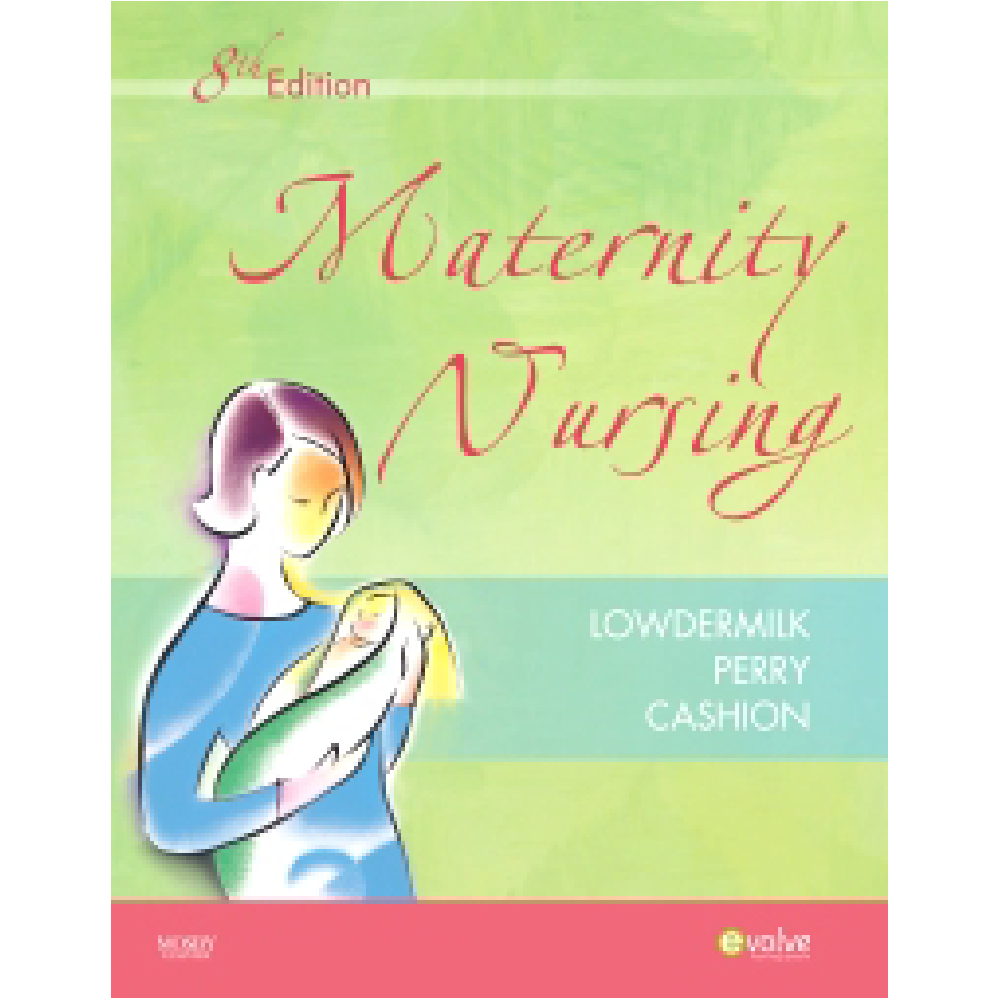Maternity Nursing 8th Edition By Lowdermilk, Perry, Cashion -Test Bank
Chapter 11: Fetal Assessment during Labor
Test Bank
MULTIPLE CHOICE
1. The nurse providing care for the laboring woman should understand that variable fetal heart rate (FHR) decelerations are caused by:
a. Altered fetal cerebral blood flow.
b. Umbilical cord compression.
c. Uteroplacental insufficiency.
d. Fetal hypoxemia.
ANS: B
Feedback
A Altered fetal cerebral blood flow would result in early decelerations in the FHR.
B Variable decelerations can occur any time during the uterine contracting phase and are caused by compression of the umbilical cord.
C Uteroplacental insufficiency would result in late decelerations in the FHR.
D Fetal hypoxemia would result in tachycardia initially and then bradycardia if hypoxia continues.
DIF: Cognitive Level: Knowledge REF: 326
OBJ: Client Needs: Physiologic Integrity TOP: Nursing Process: Assessment
2. While evaluating an external monitor tracing of a woman in active labor, the nurse notes that the fetal heart rate (FHR) for five sequential contractions begins to decelerate late in the contraction, with the nadir of the decelerations occurring after the peak of the contraction. The nurse’s first priority is to:
a. Change the woman’s position.
b. Notify the care provider.
c. Assist with amnioinfusion.
d. Insert a scalp electrode.
ANS: A
Feedback
A Late decelerations may be caused by maternal supine hypotension syndrome. They usually are corrected when the woman turns on her side to displace the weight of the gravid uterus from the vena cava.
B If the fetus does not respond to primary nursing interventions for late decelerations, the nurse would continue with subsequent intrauterine resuscitation measures, including notifying the care provider.
C An amnioinfusion may be used to relieve pressure on an umbilical cord that has not prolapsed. The FHR pattern associated with this situation most likely reveals variable deceleration.
D A fetal scalp electrode would provide accurate data for evaluating the well-being of the fetus; however, this is not a nursing intervention that would alleviate late decelerations, nor is it the nurse’s first priority.
DIF: Cognitive Level: Application REF: 326
OBJ: Client Needs: Physiologic Integrity
TOP: Nursing Process: Implementation
3. The nurse caring for the laboring woman should understand that early decelerations are caused by:
a. Altered fetal cerebral blood flow.
b. Umbilical cord compression.
c. Uteroplacental insufficiency.
d. Spontaneous rupture of membranes.
ANS: A
Feedback
A Early decelerations are the fetus’s response to fetal head compression.
B Variable decelerations are associated with umbilical cord compression.
C Late decelerations are associated with uteroplacental insufficiency.
D Spontaneous rupture of membranes has no bearing on the fetal heart rate unless the umbilical cord prolapses, which would result in variable or prolonged bradycardia.
DIF: Cognitive Level: Comprehension REF: 325
OBJ: Client Needs: Physiologic Integrity TOP: Nursing Process: Assessment
4. What three measures should the nurse implement to provide intrauterine resuscitation? Select the response that best indicates the priority of actions that should be taken.
a. Call the provider, reposition the mother, and perform a vaginal examination.
b. Administer oxygen by face mask, assist the woman to a side-lying position, and increase maternal blood volume by increasing the rate of the primary IV.
c. Administer oxygen to the mother, increase IV fluid, and notify the care provider.
d. Perform a vaginal examination, reposition the mother, and provide oxygen via face mask.
ANS: B
Feedback
A The nurse should initiate intrauterine resuscitation in an ABC manner, similar to basic life support. The first priority is to optimize oxygenation of the circulatory volume by providing oxygen via face mask. The second action is to open the maternal and fetal vascular systems by repositioning the mother for improved perfusion. The third step is to increase blood volume by increasing the IV fluid. If these interventions do not resolve the fetal heart rate issue quickly, the primary provider should be notified immediately.
B These are the correct nursing actions for intrauterine resuscitation.
C The nurse should initiate intrauterine resuscitation in an ABC manner, similar to basic life support. The first priority is to optimize oxygenation of the circulatory volume by providing oxygen via face mask. The second action is to open the maternal and fetal vascular systems by repositioning the mother for improved perfusion. The third step is to increase blood volume by increasing the IV fluid. If these interventions do not resolve the fetal heart rate issue quickly, the primary provider should be notified immediately.
D The nurse should initiate intrauterine resuscitation in an ABC manner, similar to basic life support. The first priority is to optimize oxygenation of the circulatory volume by providing oxygen via face mask. The second action is to open the maternal and fetal vascular systems by repositioning the mother for improved perfusion. The third step is to increase blood volume by increasing the IV fluid. If these interventions do not resolve the fetal heart rate issue quickly, the primary provider should be notified immediately.
DIF: Cognitive Level: Evaluation REF: 330
OBJ: Client Needs: Health Promotion and Maintenance
TOP: Nursing Process: Implementation
5. The nurse caring for the woman in labor should understand that maternal hypotension can result in:
a. Early decelerations.
b. Fetal dysrhythmias.
c. Uteroplacental insufficiency.
d. Spontaneous rupture of membranes.
ANS: C
Feedback
A Maternal hypotension is not associated with early decelerations.
B Maternal hypotension is not associated with fetal dysrhythmias.
C Low maternal blood pressure reduces placental blood flow during uterine contractions, resulting in fetal hypoxemia.
D Maternal hypotension is not associated with SROM.
DIF: Cognitive Level: Comprehension REF: 326
OBJ: Client Needs: Health Promotion and Maintenance TOP: Nursing Process: Assessment
6. While evaluating an external monitor tracing of a woman in active labor whose labor is being induced, the nurse notes that the fetal heart rate (FHR) begins to decelerate at the onset of several contractions and returns to baseline before each contraction ends. The nurse should:
a. Change the woman’s position.
b. Discontinue the oxytocin infusion.
c. Insert an internal monitor.
d. Document the finding in the patient’s record.
ANS: D
Feedback
A The FHR indicates early decelerations, which are not an ominous sign and do not require any intervention. The nurse should simply document these findings.
B The presence of early decelerations is not an ominous sign and does not require any intervention.
C The presence of early decelerations is not an ominous sign and does not require any intervention.
D The FHR indicates early decelerations, which are not an ominous sign and do not require any intervention. The nurse should simply document these findings.
DIF: Cognitive Level: Application REF: 325
OBJ: Client Needs: Health Promotion and Maintenance
TOP: Nursing Process: Implementation
7. The nurse providing care for the laboring woman should understand that late fetal heart rate (FHR) decelerations are caused by:
a. Altered cerebral blood flow.
b. Umbilical cord compression.
c. Uteroplacental insufficiency.
d. Meconium fluid.
ANS: C
Feedback
A Altered fetal cerebral blood flow would result in early decelerations in the FHR.
B Umbilical cord compression would result in variable decelerations in the FHR.
C Uteroplacental insufficiency would result in late decelerations in the FHR.
D Meconium-stained fluid may or may not produce changes in the fetal heart rate, depending on the gestational age of the fetus and whether other causative factors associated with fetal distress are present.
DIF: Cognitive Level: Knowledge REF: 325
OBJ: Client Needs: Physiologic Integrity TOP: Nursing Process: Assessment
8. Perinatal nurses are legally responsible for:
a. Correctly interpreting fetal heart rate (FHR) patterns, initiating appropriate nursing interventions, and documenting the outcomes.
b. Greeting the patient on arrival, assessing her, and starting an intravenous line.
c. Applying the external fetal monitor and notifying the care provider.
d. Making sure that the woman is comfortable.
ANS: A
Feedback
A Nurses who care for women during childbirth are legally responsible for correctly interpreting FHR patterns, initiating appropriate nursing interventions based on those patterns, and documenting the outcomes of those interventions.
B This may be an activity that a nurse performs, but it is not an activity for which the nurse is legally responsible.
C This may be an activity that a nurse performs, but it is not an activity for which the nurse is legally responsible.
D This is one aspect of caring for a woman in labor, but it is not an activity for which the nurse is legally responsible.
DIF: Cognitive Level: Comprehension REF: 329
OBJ: Client Needs: Safe and Effective Care Environment
TOP: Nursing Process: Assessment, Planning, Implementation
9. As a perinatal nurse you realize that a fetal heart rate that is tachycardic, is bradycardic, or has late decelerations or loss of variability is nonreassuring and is associated with:
a. Hypotension.
b. Cord compression.
c. Maternal drug use.
d. Hypoxemia.
ANS: D
Feedback
A Fetal bradycardia may be associated with maternal hypotension.
B Fetal variable decelerations are associated with cord compression.
C Maternal drug use is associated with fetal tachycardia.
D Nonreassuring heart rate patterns are associated with fetal hypoxemia.
DIF: Cognitive Level: Analysis REF: 318
OBJ: Client Needs: Health Promotion and Maintenance TOP: Nursing Process: Assessment
10. A new patient and her partner arrive on the labor, delivery, recovery, and postpartum unit for the birth of their first child. You apply the electronic fetal monitor (EFM) to the woman. Her partner asks you to explain what is printing on the graph, referring to the EFM strip. He wants to know what the baby’s heart rate should be. Your best response is:
a. “Don’t worry about that machine; that’s my job.”
b. “The top line graphs the baby’s heart rate. Generally the heart rate is between 110 and 160. The heart rate will fluctuate in response to what is happening during labor.”
c. “The top line graphs the baby’s heart rate, and the bottom line lets me know how strong the contractions are.”
d. “Your doctor will explain all of that later.”
ANS: B
Feedback
A This discredits the partner’s feelings and does not provide the teaching he is requesting.
B This statement educates the partner about fetal monitoring and provides support and information to alleviate his fears.
C This statement provides inaccurate information and does not address the partner’s concerns about the fetal heart rate. The EFM graphs the frequency and duration of the contractions, not the intensity.
D Nurses should take every opportunity to provide patient and family teaching, especially when information is requested.
DIF: Cognitive Level: Application REF: 317
OBJ: Client Needs: Psychosocial Integrity TOP: Nursing Process: Planning













Reviews
There are no reviews yet.